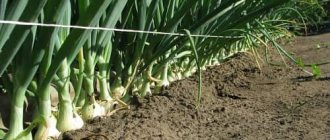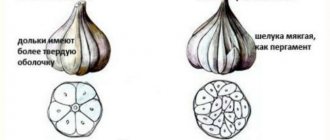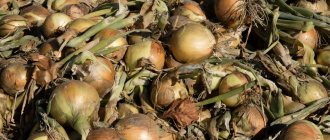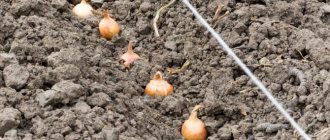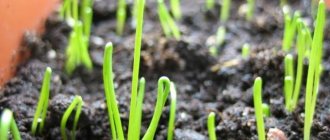- Vegetables
28.09.2020 7810
VK
Many people know that onions can be planted both in spring and autumn. Most gardeners adhere to spring planting dates, but not many practice planting onions before winter. But recently, planting onions before winter has become increasingly popular. And this is not without reason; gardeners were able to appreciate the positive aspects of such planting, and there are several of them.
It is worth noting that when planting any crop before winter, it is important to follow all recommendations regarding timing and planting technology, otherwise you can get sufficient results.
When planting before winter, it is very important to choose a suitable winter variety, determine the optimal time and place for planting, and properly prepare the bed and seed.
Advantages and disadvantages of planting onions before winter
- 1 Advantages and disadvantages of planting onions before winter
- 2 Which onions can be planted before winter 2.1 The best varieties of winter onions
- 2.2 The best varieties of winter onions and characteristics - Table
- 5.1 After what crops can onions be planted?
- 7.1 To prevent shooting
Planting onions before winter has many compelling advantages:
- It is this kind of onion that grows larger and stronger, compared to bulbs planted in the spring;
- When planted before winter, the bulbs undergo hardening in cold conditions. Such plants are already gaining strength by spring, which means they will be more resistant to diseases and pests. That is why onions planted before winter are almost not damaged by the annoying onion fly;
- Another advantage of winter planting is the reduction of weeding. The first onion shoots will appear immediately after the snow melts; the onion will have time to grow and become stronger before the mass appearance of weeds;
Another important factor is that you don’t need to worry about preserving planting material until spring. This is especially important for the smallest fraction of sowing, the so-called “oat”. Such onions will definitely not survive until spring planting; they will simply dry out. Wild oat almost never shoots, and the yield of such sets is not the worst.
- Planting onions before winter significantly saves time during the hot spring season;
- Early harvest. Onions planted before winter ripen in July. The vacated bed can be reused or sown with green manure.
The negative side of such planting is the reduction in onion yields in the event of a harsh winter. If there are sudden changes in temperature or severe frosts, the onion may die. Therefore, it is very important to approach the issue of choosing a variety correctly and not deviate from the recommendations for winter planting.
Another negative point is the inability to plant large bulbs. They almost always go straight. They can only be planted on a feather. But knowing this feature, you can provide yourself with early greens by planting a few large sets separately.
Grown from autumn-planted bulbs, the harvest stores well. But still, spring onions are stored much better.
At what depth to plant onion sets?
After the bulbs have been laid out, the furrows are covered on top with fertile soil or compost to the level of the edge of the furrows; there should be 3-4 cm of soil above the bulbs. Planting too shallow leads to the bulb freezing in winter; planting too deep may prevent the delicate feather from breaking through the thickness of the earth. The bulb may dry out or become wet in the spring.
It is not advisable to mulch the bed right away; this is done after persistent cold weather. Mown grass, fallen leaves, dry sawdust, carrot tops, and marigold stems are used as mulch. Marigolds, among other things, repel many pests. In the spring, be sure to remove the mulch from the garden bed so that the earth warms up faster.
It is not advisable to mulch the beds with peat, especially in a thick layer. Peat is moisture-absorbing, and in the spring it lies frozen for a long time. But a delicate onion feather cannot penetrate the thickness of the ice. Finally, peat greatly acidifies the soil, and onions react very strongly to this.
A good option is to sow winter seed and carrots in the same bed. In the fall, onions are sown first, leaving one furrow for carrots, which are sown later on the frozen ground. The advantage is that they will protect each other from pests. The sets are planted together not only with carrots, but also in a bed with strawberries to save space. At the same time, it will protect strawberries from fungal diseases and pests.
What onions can be planted before winter
Sets are usually divided according to the diameter of the bulbs:
- Oatmeal is the smallest onion, less than 1 cm;
- first category - from 1 cm to 1.5 cm;
- second category - 1.5–3 cm;
- samples - more than 3 cm.
For growing onions for turnips, oatmeal and sets of the first category are suitable, for feathers - the second category and selections.
The best varieties of winter onions
Not all onion varieties are suitable for autumn planting. When choosing planting material, you need to purchase seedings of varieties adapted to the climatic conditions of the region.
In the middle zone, the most popular varieties for planting before winter are:
Stuttgarter Riesen, Radar, Arzamassky, Strigunovsky, Danilovsky, Bessonovsky, Ellan, Odintsovets, Senshui, Shakespeare, Red Baron.
Each type of onion has its own taste characteristics, some are more pungent, others are more delicate. If you plant several varieties, in the future you will be able to decide on your preferences: which one tastes better, which one ripens earlier or is more productive. The main characteristics of popular varieties of winter onions are presented in the following table.
The best varieties of winter onions and characteristics - Table
| Onion variety | spicy | size | storage | maturation |
| Arzamas | spicy | small | recumbent | |
| Bessonovsky | spicy | small | recumbent | 80 |
| Buran | spicy | recumbent | 68-83 | |
| Danilovsky | spicy | small | recumbent | |
| Danilovsky-301 | semi-sharp | large | 100-110 | |
| Lugansk | spicy | large | recumbent | 95-105 |
| Muzona | semi-sharp | few | 90-110 | |
| Myachkovsky-300 | 65-75 | |||
| Panther F1 | recumbent | 130-135 | ||
| Radar or Raider | spicy | recumbent | 250-260 | |
| Red Baron | spicy | large | recumbent | 95-110 |
| Ruby | semi-sharp | average | average | 80-90 |
| Senshui | spicy | large | recumbent | |
| Siberian | recumbent | 90-100 | ||
| Strigunovsky | spicy | average | recumbent | 110-120 |
| Sturon | semi-sharp | average | recumbent | 105-110 |
| Tamara F1 | 105-110 | |||
| Chalcedony | spicy | average | recumbent | 90-95 |
| Black Prince | semi-sharp | 100-105 | ||
| Shakespeare | semi-sharp | large | average | |
| Stuttgarter Riesen | spicy | average | recumbent | 70-120 |
| Ellan | sweet | recumbent |
Varieties and hybrids of winter onion sets
Onion varieties and hybrids are suitable for winter planting:
- early ripening - Bogatyrskaya sila, Bessonovsky, Myachkovsky 300, Odinovets, Siberian annual, Spanish medallion F1, Skorospelka, Stuttgarter Risen;
- mid-season - Danilovsky 301, Carmen MS, Krepysh, Chalzendon, Ecstasy, Tamara F1;
- late ripening - Comet, Lugansky, Rubin (red), Sturon.
Planting onions before winter: optimal timing
When planting onions before winter, it is very important to determine the timing correctly.
If planted early, the bulb will have time to germinate. And if planting is delayed, it will not have time to take root before frost. In both cases, the onion may not survive the winter well, which will negatively affect the harvest in the future.
When planting onions before winter, you need to choose a time so that the onion has time to form roots before the soil freezes, but cannot germinate. If the feather of the bulb grows 1-2 cm, there is nothing terrible about it. If the planting depth is observed, such a bulb will overwinter normally. It is much worse if the bulb grows significantly. Beds with such onions must be mulched to avoid their death. And in winter, you can add additional snow to such beds.
In order to correctly determine the date of planting, you need to focus on current temperature conditions and the weather forecast.
Planting can begin if the temperature is around +5°...+7°C for several days, and a gradual decrease in temperature is expected.
To determine the time for planting onions in different regions, you need to focus on the climatic conditions of the region and the current weather conditions at the moment.
So in the middle zone this is a period from approximately the end of September until the 20th of October.
In any case, you need to plant onions at least a month or even a little more before the onset of cold weather.
To make it easier to figure out timing, try planting onions at different times. By analyzing the results, you can experimentally determine the optimal time for planting winter onions in your area.
Planting dates - when to plant onion sets
Experienced gardeners recommend planting onions 1-2 weeks after planting winter garlic. Our country is large, so planting times vary in different regions. So, in central Russia it is better to sow after October 20th. The southern regions begin sowing in late November - early December. In more northern regions, sowing dates will be slightly earlier than in central Russia.
Sometimes it is advised to plant seedlings on frozen ground. This is not entirely true. Before frost, the bulbs must take root, but do not have time to shoot, otherwise they will freeze. Therefore, the optimal period is 3 weeks before permanent frost. To avoid mistakes, you will have to listen to weather forecasts.
What to do if you are late planting onions?
If for some reason you did not have time to plant onions before winter, then you need to act according to the circumstances.
If there have not been frosts yet, then the ground must be carefully covered so that it does not freeze. For these purposes, a layer of compost (of course, preferably thicker), humus, covering material folded several times and other materials is suitable.
Experienced summer residents advise that if there are not a lot of onions, then you can bring a couple of buckets of earth into the house, to the stove. The next day, when the earth has warmed up, you can plant, spreading the heated soil directly into the furrows.
If there is a lot of onions, then it is better to sort them out. Leave the large ones until spring, and plant the small ones.
You need to be wary of the advice to “spill the ground with hot water.” In damp conditions, the bulbs may rot.
Features of planting winter onions
Landing in the Moscow region
Planting onions in the Moscow region is almost no different from cultivating them in Ukraine or other warm regions. The only problem can be a too cold winter, but if the temperature does not drop below -15 ºC, and you cover the onions for the winter, then they will not be in danger of freezing. If the frosts are stronger, but there is a lot of snow, then we can only hope that in this case everything will go well.
How and when to plant garlic in the fall in open ground
Planting onions in autumn in the Urals
Planting and caring for winter onions in the Urals is somewhat different from growing this crop in areas with a temperate climate. For example, planting dates shift closer to the beginning of autumn - from late September to mid-October. Shelter for the winter in the Urals is mandatory, in addition, not every variety can be planted before winter in the Ural climate, but only those that have high winter hardiness.
In the photo: Young onion
How to plant in Siberia
Unfortunately, severe Siberian frosts do not allow us to speak with confidence about the possibility of cultivating winter onions in this region. If you guess the timing of planting, the variety and the winter weather, it is quite possible that your efforts will be crowned with success. But if you are unlucky, you can always sow onions in the spring.
How to plant onions before winter
After what crops can onions be planted?
It is very good to plant winter onions in a bed where cucumbers, tomatoes, corn, beets, and grains previously grew. It is not recommended to plant it after onions, cabbage, and garlic.
When growing onions, it is very important to observe crop rotation. You cannot plant onions in one place year after year.
How to choose a place and prepare a bed for planting onions
Just like for garlic, you need to choose a bed for planting onions in a sunny place at a slightly elevated position. Under no circumstances should you choose areas where water stagnates in the spring. Like all bulbous plants, onion sets will simply rot in such conditions.
It is advisable to choose a place on the site so that in the spring the snow melts there as early as possible.
The bed for autumn planting of onions must be prepared in advance so that the soil has time to settle.
If you plant onions immediately after digging up the ground, there is a risk that the soil will later become compacted and settle. The onion will end up on the surface of the soil and freeze.
Onions prefer fertile and loose soil with an acidity close to neutral. If the acidity is high, then you must add lime or dolomite flour.
To improve the soil, compost or humus is added before digging - 5-6 kg per m².
As for fertilizers, add fertilizers from the “Autumn” series or superphosphate 20-25 g per 1 sq. m. meter and potassium salt 10-15 g. Potassium fertilizers can be replaced with ash, which also helps reduce soil acidity and serves to prevent various rots.
It is advisable to make the beds raised to a height of up to 15 cm; water is guaranteed not to stagnate on such beds. If the soil is dense and heavy, then creating raised beds is simply necessary.
Preparing the soil for autumn planting
The soil for planting seedlings is prepared immediately after harvesting in the selected bed.
Remove plant debris and root remains. They do a deep dig on the bayonet of a shovel. Lightly incorporate humus into the soil at the rate of 5 kg per 1 m² and potassium-phosphorus fertilizers according to the instructions. Water the bed with a strong solution of potassium permanganate to disinfect the soil.
How to prepare onions for planting
Preparing seedlings for winter has its own characteristics. First of all, it needs to be visually inspected - the seed must be dry, hard, without signs of rot. Sick, damaged, dried onions must be removed from the planting material.
Then it needs to be calibrated, divided by size: separate the small ones - wild oats, sets and selections. Part of this seedling will be used for turnips, the other for growing greens.
- wild oatmeal (up to 1 cm in diameter) - on the head (turnip);
- sevok (diameter from 1 to 2 cm) - on the head and partly on the feather (greens);
- large (diameter more than 2-3 cm) - only for greens (very early).
| Important! The larger the size of the bulb, the better the greens will be; if the fractions are too small, the feather will take a very long time to develop and will be quite small. |
Pre-sowing preparation of onion sets is a very important stage. And it is as follows:
- Sorting and sizing . Dry, rotten bulbs are removed and the seed is arranged according to size. They should not be planted interspersed, but in different places. The largest ones are best used on a pen. They are more likely to be shot. And the smallest sets are best suited for autumn planting and produce large heads.
- Warming up onion sets . This is carried out in order to “wake up” the seeds and this operation prevents the onion from bolting. Can be placed where the temperature is 20°C for at least 20 days. Then for 10 hours to where it is about 40°C. You can quickly rinse with very hot water and dry.
- Hardening . Dip the bulbs in water at a temperature of 45-50°C for 15 minutes. After this, leave in cold water for the same time. Cold and hot shower;
- Onion processing, disinfection. It is done in order to protect the seedlings from damage by fungal diseases. This soaking is carried out immediately before planting. Typically, a slightly pink solution of potassium permanganate or a pale blue solution of copper sulfate (from late blight) is used for this. Leave the sets in the solution for 2-3 hours. After this, you need to dry the bulbs well.
- Using saline solution. To reduce the risk of plant infection with stem or onion nematodes. Preparation of the solution: take 1 tablespoon of table salt per 1 liter of water. Immerse the onion sets in the mixture for 10-20 minutes. You can use baking soda instead of salt.
Choosing the right variety
Winter-hardy varieties of onions are suitable for autumn planting. As a rule, these are varieties with a spicy or sweet-spicy taste. In order not to make a mistake, you can take planting material grown by local summer residents. Such onions are already adapted to the growing conditions of a specific climate zone.
When purchasing from a garden center, choose zoned varieties. Among the leaders are:
- Strigunovsky local;
- Timiryazevsky;
- Arzamas;
- Red Baron;
- Snowball;
- Sturon;
- Aleko.
If the onion sets are small, planting in the fall is the only right decision. Even if such bulbs survive until spring, they will be in a deplorable state - they will shrivel and be unsuitable for planting.
Prevention of bolting and diseases
The following measures are necessary to prevent diseases and prevent bulbs from bolting in the spring
To prevent shooting
- Dip the bulbs in a warm solution of potassium permanganate (50-60°C) for 20 minutes, when planting, pour hot water into the grooves
- In order for the seedlings not to go to waste, they need to be warmed up well at a temperature of 50-60°C before planting. I usually hang it in a canvas bag near the battery for 2-3 days, so that the bag does not touch the battery. It dries out at the same time.
For disease prevention
- Treatment with the drug “Maxim”, “Fitosporin” according to the instructions. Immerse the seed in a saline solution (1 tablespoon of salt per 1 liter of water) for 3 hours, then in a saturated solution of potassium permanganate for 3 hours.
| Important! In autumn, seedlings need to be treated 7-10 days before planting. Then it must be dried. |
Dry bulbs withstand sudden cold spells better than swollen bulbs, and the latter may begin to germinate too quickly.
Why is it necessary to plant winter onions?
Pre-winter planting of winter-hardy onion varieties guarantees an early and fairly abundant harvest, which are the main reasons for carrying out planting work in the cold season.
- Additional benefits include the following:
- relative saving of time and leisure in all actions performed (in the autumn period there is much less gardening work than in the warm season);
- early germination period (on average, winter vegetables germinate 2–3 weeks earlier than spring vegetables, which means that after harvesting them you will still have time to plant other cultivated plants in the same area);
- lack of bolting in small onions (wild oats), which cannot be said about large onions, the planting of which should be moderate (however, if you are interested in early greens, then you should still pay attention to the last option);
- almost complete absence of pests and diseases, in particular the popular onion fly, gray rot, powdery mildew (thanks to this, there is no need to constantly loosen the soil and remove weeds);
- abundant and high-quality harvest (the size of the bulbs during winter planting will be slightly larger than during spring planting);
- increased shelf life (varieties with small bulbs are best preserved, although large bulbs retain their basic characteristics much better than spring bulbs).
Did you know? The largest onion, listed in the Guinness Book of Records, weighs 8.490 g, and at its widest point has a girth of 81 cm. The gardener-record holder in this case is 49-year-old resident of Leicestershire (England) Tony Glover.
Planting onions before winter - technology
Planting onions before winter - description of technology :
- To plant, you need to level the bed, then make holes or cut grooves according to the scheme:
- the distance between the grooves is 15-25 cm. This is the optimal distance for processing row spacing with a flat cutter when caring for onions in spring;
- groove depth - 5-8 cm (depending on the size of the bulb). Before winter, the planting depth should be greater than when planting in spring. For the smallest set - wild oatmeal, make the furrows no deeper than 2-3 cm, otherwise it will not have enough strength to germinate in the spring;
- the distance between the bulbs is 7–8 cm. You can plant onions more often. Then in the spring, when thinning out the plantings, some of the onions can be used for greens.
- When planting onions only on the feather, the distance between the onions is slightly different. They are placed closely so that in the spring the plant directs its forces not to the growth of the bulb, but to the feather.
- Spread or stick in the sets. If you have heavy clay soil, then it is advisable to pour river sand at the bottom of the beard, then add more sand on top of the bulb. All bulbous crops prefer loose soil. This technique will help avoid the death of the onion from waterlogging in heavy, damp soil.
| Before planting, you cannot cut off the neck of the bulbs, otherwise you will get a feather instead of a turnip. |
3. Sprinkle the bulbs with soil and compact them lightly. Level the bed with a rake so that the bulbs emerge evenly in the spring.
- If the soil is relatively moist, then there is no need to water, so as not to provoke strong plant growth. If there is no rain, then 10 days after planting you will need to water the bed.
- The beds can be sprinkled with humus, compost or sawdust.
Features of autumn planting of large sets on a feather
To obtain greenery in the spring, use samples of 3-4 cm in size. The bulbs are placed on the bed:
- bridge method - planted close to each other;
- tape - selections are placed at a short distance between the bulbs in a row, grooves are made in increments of 20-25 cm;
- nesting method - the onions are planted side by side, 3-4 pieces at a time, with an interval of 15 cm in a row, furrows are made at a distance of 20-25 cm.
Before planting, the tail is cut off and the outer scales are partially removed.
Caring for onions after planting
Winter onions do not require special care after planting. It is necessary to cover the beds with planted onions only when the soil freezes slightly. Immediately after planting, you should not cover it, as the onions can get wet. .
After the onset of light frost, you need to mulch the bed with fallen leaves, spruce branches, dry tops, dry sawdust, straw, peat or other materials. Cover the top with branches, poles, etc. (to hold snow). In winter, you need to throw snow on the garden bed; this is the best protection against freezing.
| Note! The need for mulching and shelter for the winter depends on the climate of our region. If you have snowy winters without much frost, then you don’t have to cover them with anything. |
With the onset of spring, when the snow melts and the soil begins to thaw, all coverings should be removed, because the ground underneath, on the contrary, will only take longer to warm up.
The mulch also needs to be removed so that the soil warms up faster. After the emergence of seedlings in early spring, it is necessary to fertilize the bed.
Harvesting and storage features
A month before harvest, watering is stopped . The onion ripens and gains vitamins. When the onion feather has completely fallen onto the bed and the neck has become dry, it is time to harvest. This is done in dry, sunny weather. The collected heads are laid out on the garden bed and the soil is allowed to dry.
For storage, onions are stored in a dry, cool room - a basement or storage shed. The dry feathers are trimmed, the turnips are laid out in nets or baskets, braided and hung. “Grandma’s method” of storage is to hang onions in stockings.
Benefits of planting in autumn
There are several advantages of planting onions before winter:
- Winter onions produce a harvest earlier than spring onions by approximately 2-4 weeks. They are collected in July, and something else can be planted in the place of germination;
- Small wild oatmeal (sets) practically do not shoot, but large ones definitely shoot, but produce fragrant early greens. Therefore, this moment is left to the discretion of the gardener;
- Thanks to natural selection in cold weather conditions, the harvest will be healthy and of high quality;
- Many pests that affect early crops (carrot flies, cruciferous flea beetles, etc.) do not affect early onions;
- There are no weeds that cannot compete in growth with early onions. Thanks to this, there is no need for weeding;
- Sufficient level of moisture for the formation of bulbs, thanks to snow melting;
- The bulbs are larger than those of the spring type, but are stored a little worse;
- Saving time, because in the fall there are fewer worries than in the spring.
How to properly prepare the soil and cultivate beds
Onions love loose neutral soils.
When placing a bulb bed, consider these nuances:
- choose a well-lit place;
- do not allow water to stagnate;
- the predecessors should be carrots, potatoes, tomatoes, cabbage.
A few days before planting, the soil is dug up and organic fertilizers are added.
Before planting, disinfection measures are carried out - the beds are spilled with a solution of copper sulfate: 2 tbsp. l. for 10 liters of water. Then they begin to plant the prepared onions.
